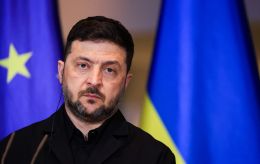Dollar exchange rate to become flexible in Ukraine: reasons and consequences
 Photo: The exchange rate from October 3rd will become flexible but managed (Vitalii Nosach/RBC-Ukraine).
Photo: The exchange rate from October 3rd will become flexible but managed (Vitalii Nosach/RBC-Ukraine).
Starting October 3rd, the National Bank of Ukraine introduced a managed floating exchange rate regime. However, this does not mean the dollar has been set free to "free floating." RBС-Ukraine has gathered answers to the main questions.
During the preparation of the material, the following sources were used: press releases from the National Bank, statements by the head of the NBU Andrii Pyshnyi, as well as his deputies Yurii Heletii and Serhii Nikolaichuk, and an exclusive comment from the head of the analytical department of Concord Capital, Oleksandr Parashchii.
Why is there a need to transition to a flexible exchange rate?
The National Bank hopes that the new exchange rate regime will strengthen the resilience of the Ukrainian economy and currency market and reduce the risks of accumulating foreign exchange imbalances.
Managed flexibility will be the next step in returning to inflation targeting. This is a monetary policy regime aimed at ensuring price stability in the country.
Prerequisites for the transition were:
- a steady decrease in inflation;
- accumulation of significant international reserves;
- an increase in the attractiveness of hryvnia deposits and domestic government bonds (DGB).
Ukrainian and global experience shows that a prolonged fixed exchange rate leads to imbalances and severe problems in the future.
This can weaken the economy and financial system right now and complicate the revival of business activity during Ukraine's recovery phase.
"Most Ukrainians remember the 2008 and 2014-2015 currency crises when the national currency was significantly weakened. The depth of these crises was largely exacerbated due to the multi-year fixation of the rate," added the NBU.
Maintaining the exchange rate over many years typically ends the same way — foreign exchange imbalances accumulate, and international reserves are exhausted, followed by a deep devaluation and economic decline.
Did the IMF demand a flexible exchange rate?
The head of the NBU, Andrii Pyshnyi, said that the currency liberalization strategy and the transition to flexible exchange rate formation were among the structural beacons in agreements with the International Monetary Fund.
"We are moving within the framework of a strategic goal, even a step-by-step plan, which can be traced based on our public communications and the respective decisions taken," he added.
What will change for Ukrainians?
From tomorrow, the official exchange rate will be determined by operations on the interbank foreign exchange market with the participation of the National Bank.
The rules for setting the cash and card exchange rates will remain unchanged. It is in these market segments that the population buys and sells currency. The rules will be the same as they have been for the last year and a half.
It should be noted that the exchange rate was not fixed; there were both decreases and increases. For example, in July 2023, the cash dollar in sales dropped below 37.2 hryvnias.
The new mechanism should also bring the cash rate closer to the official one.
In particular, the NBU will increase banks' ability to satisfy cash demand. Either to soften restrictions on purchasing currency in the cash market or online.
According to Pyshnyi, the decision mainly concerns businesses that buy and sell currency on the interbank market. He also noted that Ukrainians have been living under a flexible exchange rate regime for a long time. Since the beginning of the year, the hryvnia has strengthened against the dollar by 7%, while it fell by 50% last year.
Has the exchange rate been set "adrift"?
Managed flexibility differs from the floating exchange rate regime that was in place until February 24, 2022. With the new regime, the regulator will continue to monitor the foreign exchange market, remaining a key player.
The National Bank will compensate for the structural currency deficit. As a result, the rate can change in both directions: it can rise and fall.
Moreover, the regulator promises to limit exchange rate fluctuations, preventing sharp devaluation or appreciation of the hryvnia.
"The NBU did not set the exchange rate free. No. We haven't returned to the floating exchange rate regime before the full-scale invasion. We haven't even considered this option yet, given the structural currency deficit in the market," said Andrii Pyshnyi.
The pre-war regime was unsuitable since the market had a structural currency deficit. With a floating rate, such a situation would lead to a constant fall of the hryvnia. Managed flexibility will allow compensation for the structural difference between demand and supply.
As of today, international reserves amount to about 40 billion dollars. This enhances the ability to maintain exchange rate stability.
How will the National Bank stabilize the cash market?
According to Yurii Heletii, the deputy head of the NBU, the National Bank will continue to monitor the market after transitioning to managed flexibility. He also pointed out that last year, the difference between the official fixed rate and the cash rate in 2022 reached 20%, and this year, after easing currency restrictions, it dropped to 3%.
"We have a toolkit for dealing with these multiple rates... We've allowed non-cash purchases of up to 50,000 hryvnias, and we've increased the deposit limit from 100 to 200 thousand hryvnias," he said, adding that the NBU has strategies to influence demand in the cash market, moving it to the non-cash segment.
Is there a corridor within which deviation from the current rate can occur?
As explained by Heletii, the NBU has a tactic that cannot be detailed.
"As mentioned, our priority is to ensure stability in the foreign exchange market. And believe me, we have a robust toolkit to achieve this," he said.
Serhii Nikolaichuk, Deputy Head of the NBU, added that the regulator would allow currency fluctuations and likely smooth them out daily.
"We don't announce specific parameters of our interventions. But these parameters, especially in the early stages, will minimize fluctuations," he emphasized.
The National Bank also noted adhering to a "constructive ambiguity" to avoid speculations in the foreign exchange market.
What will now happen with the dollar?
"Unfortunately, we never give forecasts and our view of the optimal rate. We talk about our goal. The goal and priority remain inevitable. Exchange rate stability is one of the most important components of our stability," said Andrii Pyshnyi.
Will there be new relaxations in the foreign exchange market?
As stated by the National Bank, during the third phase of currency liberalization, an increase in the volume of money transfers is expected. Currently, preparations are underway for the final steps of the first stage.
The rate will be set daily. What will it be tomorrow?
From tomorrow, banks will be able to buy and sell non-cash currency at a rate they set independently without a 1% restriction from the previous rate.
"The rate at which the market will operate tomorrow is 36.57 hryvnias per dollar. We will see how the trading goes tomorrow, draw conclusions, and decide in the afternoon, at 15:30, regarding the rate for the next day," emphasized Yurii Heletii.
It is worth noting that according to the head of the analytical department of Concord Capital, Oleksandr Parashchii, the dollar rate will remain below 37 hryvnias.
"It's important to understand that the NBU will continue to support the rate with its interventions actively. The rate will depend on how actively the National Bank will influence the foreign exchange market. I think it is very interesting to demonstrate the stability of the hryvnia in the coming weeks. It will keep the rate below 37," he said in a comment to RBC-Ukraine.
Is there a prospect of returning to a fixed rate?
Depending on the market situation and macroeconomic conditions, the National Bank will adjust the parameters of its interventions and, if necessary, narrow or expand fluctuations.
"Currently, we have no restrictions that we will not return to a fixed rate, but it is not our base case," emphasized Serhii Nikolaichuk.
As specified by Pyshnyi, the current military campaign is of great significance. And depending on its development, decisions will be made regarding the foreign exchange market.
Does it make sense to buy up dollars en masse? What does the NBU say?
The National Bank pointed out that the currency liberalization strategy makes hryvnia assets attractive.
"Accordingly, we do not plan to allow fluctuations that would question the attractiveness of hryvnia assets. This is an important message we are trying to convey. That assets in Ukrainian currency are quite profitable. There is no particular sense in converting all your savings into foreign currency," added Nikolaichuk.

